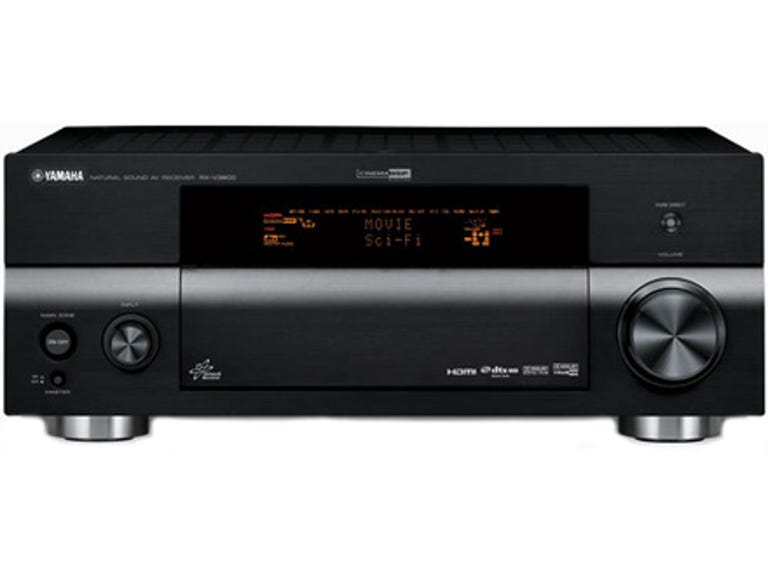 Why You Can Trust CNET
Why You Can Trust CNET Yamaha RX-V3800 review: Yamaha RX-V3800
The Yamaha RX-V3800 boasts all the features expected of a top-of-the-line receiver, and while audio performance is exceptional video could use some work.
Though it's been a buzzword for years, Yamaha was one of the first companies to attempt "convergence" in their range of AV gear. While the MusicCast may not have sold like the Xbox 360 it helped in some small way to introduce media streaming to the masses. Even if companies like Apple are still struggling to popularise it.
The Good
The Bad
The Bottom Line
The RX-V3800 is the latest and greatest "multimedia" receiver from Yamaha, but now that other companies have jumped upon the streaming bandwagon, how does it cope?
Design
Around the rear the Yamaha gets a little messier with almost every square inch covered with sockets. They're logically arranged, but we did find that the speaker connections are a little cramped if you're not using banana plugs.
The remote is a learning model, and is almost identical to that which ships with the V2700. It's chunky, and the playback buttons are a little small, but it's functional and pretty easy to program.
Features
Music streaming and Internet radio capabilities are kept on from the previous model, though neither the interface nor the technology seems to have changed. While this is good for Internet radio, which works well and provides a decent selection of stations by default, the streaming implementation is a bit arcane and still needs a running PC to stream from.
The most significant change, and one which future-proofers will appreciate, is the addition of full HDMI version 1.3 capabilities. Some early Blu-ray disks, including our usual Mission Impossible III test disk, don't include the latest HD audio. However, disks such as Spiderman 3 include both Dolby TrueHD and DTS-HD Master soundtracks and can make the most of a receiver like the RX-V3800. For your trouble you get four of these HDMI inputs, which should last most people a good while.
Performance
In fact, when we bypassed the onboard decoder of the Sony S500B we were greeted by one of the best surround-sound experiences we've ever had from a modest system. When Sandman emerges for the first time, you see what looks like rocks, but with the RX-V3800 the audio clues are always there -- it sounds like sand. Treble detail was handled very delicately. While the onboard decoder of the Sony player is very good the sand particles looked and sounded like granite boulders -- the subtleties were lost.
We found that stereo music was best served by using the Pure Direct function, which essentially shuts down all the circuits unnecessary to making music -- namely video and the front display. Stereo focus is sharpened and instruments gain a breathy, "right there" quality.
It may sound like a cliché, but we actually did have to check if the rear speakers were on when listening to Nick Cave and the Bad Seed's Red Right Hand. The soundstage was incredibly wide, and yet audio detail and the fine interplay between the vocals and the bass weren't lost in the track's general hubbub.
Where the receiver didn't live up to all the expectations for an AV switcher was in its video processing capabilities. The unit will upscale from 480/576 all the way up to 1080p, and for this we found it did a very good job. However, deinterlacing was another issue. Unlike some competitors, the Yamaha chooses not to use the Faroudja DCDi chipset or equivalent, and the results are telling. For example, there was a tendency for the Yamaha's deinterlacing of an SD source -- in this case Foxtel Digital -- to introduce some image compression artefacts such as some colour stepping and ghosting. Tearing and combing effects were also in evidence.
Trying to use the RX-V3800 with Vista connected resulted in a no-show. We've had some success using the RX-V2700 with a Windows PC running Media Player 11, but even that was flaky. Once working, the interface is rudimentary and the list of supported files short -- this is not the receiver to realise your media streaming dreams, then. We hate to say it but the Apple TV is still one of the easiest to set up, if fairly crippled.
Until Yamaha unveils their Z11 receiver -- which should be any day now -- the RX-V3800 is the company's top-of-the-line receiver. It ticks all the boxes for features -- some more successfully than others -- and should provide most home cinema set-ups with the room they need to grow.


